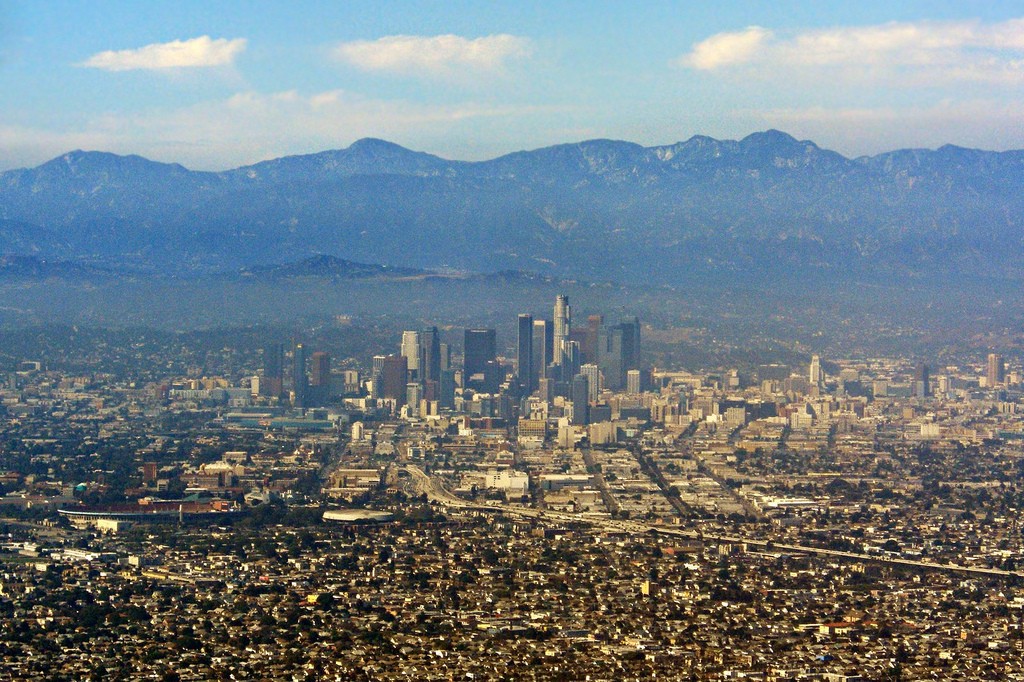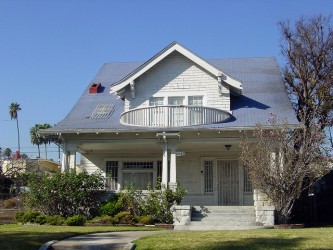
Experts say thousands of Los Angeles homes will collapse in a large earthquake.| Cameron23, Flickr Creative Commons
Imagine the Los Angeles skyline in its entirety. Include the apartment and commercial buildings; the houses old and new. Now, imagine 50 percent of those buildings gone—collapsed either partially or completely.
That is the bleak picture that U.S. Geological Survey seismologist Dr. Lucy Jones painted for attendees during the 2015 Great California ShakeOut Breakfast Leadership Summit on Sept. 30.
Los Angeles has not experienced a major earthquake in 20 years. The last large temblor to slam the region was the 1994 Northridge earthquake. Since then, California faults have been in a quiet period that Jones and other experts on her team insist won’t last.
The period of smooth sailing has caused home and commercial building owners to relax their approach to protecting structures against the damage they could sustain in the violent shaking during a substantial quake.
Lack of action to strengthen structures, however, renders the millions of people who live and work in the city’s 300,000 unstable buildings susceptible to displacement from work or homes, and even disaster-related death.
South L.A. is particularly vulnerable due to the large number of older buildings, the composition of the ground beneath these structures, and the high population of renters and low-income individuals who are less likely to be able to sufficiently prepare for catastrophe.
To better outline what Angelenos had in store if the city continued without a change to its building code, Jones referenced the 2011 quake in Christchurch, New Zealand.

The destruction following the 2011 6.3 quake in Christchurch, New Zealand.| Martin Luff, Flickr Creative Commons
Measuring 6.3 on the richter scale, the energy released in the seismic jolt transformed the city’s downtown skyline. Nearly five years later, the town is still rebuilding, but is on a steady recovery from the damage.
The Richter scale measures ground shaking in an earthquake on a scale of one to 10. Each full point in increase magnifies the shaking movement 10 times. A 5.3 earthquake would produce 10 times more movement than the four-point shaking many Angelenos felt during the 2010 Easter earthquake centered in Baja California.
“Christchurch is getting back to work and they had 95 percent insurance coverage,” Jones said.
Jones said Los Angeles property owners, on the other hand, have let building preparedness slide through their fingers as the ground has ceased to shift dramatically beneath their feet over the past two decades.
Earthquake insurance coverage began to rise after the 6.7 Sylmar earthquake in 1971. By the time of the 1994 Northridge quake, which also measured at a 6.7 magnitude, 40 percent of Los Angeles’ buildings were covered. Today, that percentage has dropped to a dismal 10 percent.
According to Glenn Pomeroy, CEO at the California Earthquake Authority, the number of those insured has dropped due to to three factors: a tendency to forget the past, the misconception that the government will step in, and the high price of earthquake coverage.
Pomeroy said the CEA is lowering their premiums. According to materials provided at the 2015 Great California ShakeOut Breakfast Leadership Summit, owners of condo units, mobilehomes and houses would pay between $386 and $820 per year, while renters would pay just over $10 per month for coverage.
Even with the proposed changes, the percentage of earthquake-insured Californians won’t soar overnight and when they do, a portion will remain without coverage.
“What are we going to do when 90 percent of our people can’t afford to rebuild the houses that they lost,” Jones asked.
On Oct. 9,Los Angeles Mayor, Eric Garcetti and the city of Los Angeles answered Jones’ question.
The city voted unanimously in favor of implementing the strictest earthquake safety regulations in the nation, requiring building owners to retrofit their structures within anywhere between seven and 25 years depending on the type of structure.
Still, despite the city’s good intentions, South L.A. remains vulnerable with a unique set of concerns.
“If you don’t have the money, it is ignorant of us to pretend that in all of the communities we do our work in, our message will carry the same weight,” said Jarrett Barrios, Regional Chief Executive Officer of the American Red Cross, Los Angeles. “It’s not because people don’t want to take action, they can’t afford to take action.”
Retrofitting the old houses and wooden apartment buildings will cost owners tens of thousands of dollars and could push renters from buildings depending on the level of retrofitting needed. Not to mention the potential hike in rent to cover the unexpected costs.
Barrios detailed the many ways in which socioeconomics create a complex situation in communities like South L.A.
“That calls upon us—kind of like a social justice—to do more than just talk generally about preparedness,” Barrios said. “It calls us to change the way we do preparedness so that our message is resonating; so that people are taking actions in those most vulnerable communities.”
Mark Benthien, Director of Communication, Education and Outreach for the Southern California Earthquake Center, and a South L.A. resident, acknowledged the lack of control renters have over taking action on the issues.

Homes like this, constructed in the early 1900s are most susceptible to destruction.|Michael, Flickr Creative Commons
The main concern in South L.A. is dealing with the vast number of homes built in the 1920s and 1930s. Many of the structures have small crawl spaces and are not bolted to their foundations.
“You’re going to have a situation where if the earthquake intensity of the shaking is really strong in South L.A. there will be a lot of people’s houses falling off their foundation,” Benthien said in an interview. “You’d have a lot of gas line breaks because of that. Some people may be able to turn their gas off, but maybe not. You’d have a lot of fires.”
Supposing that water lines would be broken, water would likely be unavailable to douse the fires, putting thousands of individuals in danger of not only homelessness with the collapse of their abodes, but also at risk for injuries sustained in explosions and subsequent fires that Benthien said could span entire neighborhoods
“Renters can ask if there is a gas shut off valve on the building,” Benthien suggested. “Ideally they would ask that before they would choose to live there, and choose to live somewhere else if there’s not. Then it becomes an incentive on building owners to install those.”
For those residents already living in buildings and unable to move to be better prepared for earthquakes, an application named Temblor can help assess just how prepared they may need to be. Although the app is one designed for home and building owners, one for renters is currently in development.
Still, renters may download Temblor or visit the website and plug in just a few details like the address, approximate square footage of the building, and the approximate year of the building’s construction to assess how much damage their building is likely to sustain in the “big one.”
For those who don’t know the age of the structure in which they are living, a map tool constructed by Built:LA can identify the construction date of a majority of buildings erected between 1890 and 2008.
Based on how much structural damage is predicted on Temblor, residents can then decide how prepared to be when building a bare essentials earthquake survival kit.
When it comes to South L.A. and the struggles it will undoubtedly encounter in the event of a large scale quake prior to the completion of the entire Los Angeles mandatory retrofit, Benthien and Barrios said there is no easy fix.
“Affording it doesn’t mean [owners] will [retrofit] because as Jarrett Barrios was saying there are so many priorities. Rich people don’t even retrofit their homes because people in general just don’t want to deal with this,” Benthien said. “There are all sorts of socio-economic issues.”
The foundation for all of them, however, was perhaps best presented by Barrios in the conclusion of his presentation:
“We need to understand that we have a greater challenge in some neighborhoods in this city than in others.”















Speak Your Mind